If you've ever found yourself in the unfortunate situation of spilling coffee on your car seat, you know how frustrating it can be. Acting quickly is crucial to preventing those stubborn brown marks from becoming permanent residents. I've learned the hard way that timing and the right cleaning techniques can make all the difference. From immediate blotting to using targeted cleaning solutions, there are steps you can take to save your car's upholstery. But what works best? Let's explore the most effective methods to guarantee your car seats stay stain-free and pristine.
Understanding Coffee Stains
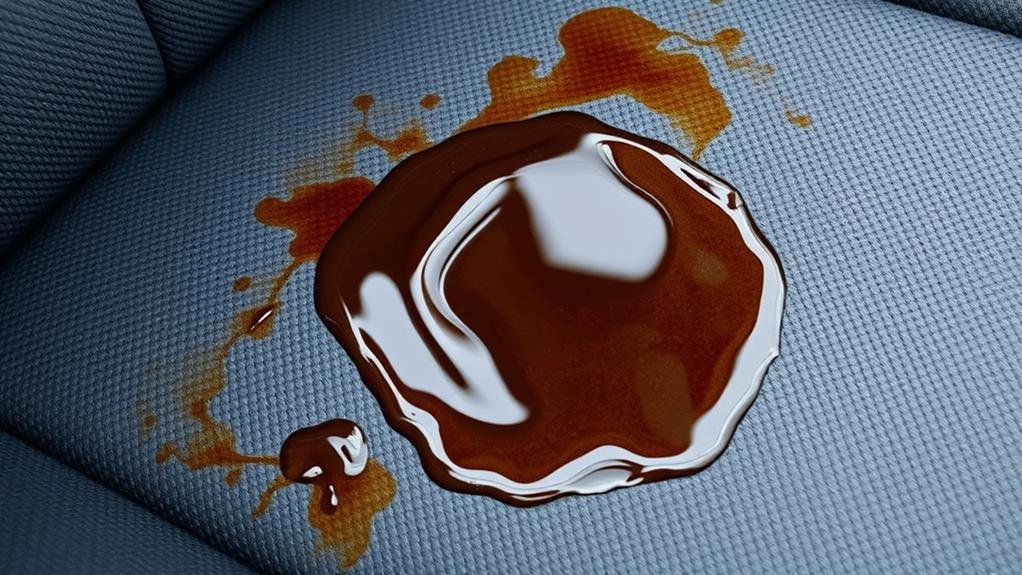
When you spill coffee on your car seat, the stain can be a real challenge to remove. This is largely due to the presence of tannins in coffee. Tannins are natural compounds found in plants that help deter animals from consuming them, and they also contribute to coffee's unique flavor. However, these same tannins make coffee stains particularly stubborn. The acidity in liquids like lemon juice, which is effective for cleaning coffee makers, can also aid in the stain removal process by breaking down the coffee's components. Understanding how to use natural cleaning agents can greatly enhance your effectiveness in tackling coffee stains, similar to the cleaning process with lemon juice.
The chemical composition of coffee, including its tannins, oils, and roast level, can deeply penetrate fabrics and lead to difficult-to-remove stains on car seats. Unlike other spills, coffee can seep into the upholstery quickly, making immediate action essential for effective stain removal. The severity of the stain can vary depending on these factors; for instance, darker roasts and higher oil content can result in more stubborn stains.
Old coffee stains may also develop a musty odor over time, emphasizing the importance of prompt cleaning. Understanding these characteristics is key to tackling coffee stains effectively and maintaining the cleanliness and freshness of your car's interior. Knowing how tannins interact with upholstery helps you approach stain removal with the right strategies and cleaning products.
Immediate Action Required
When you spill coffee on your car seat, acting quickly is key. I always blot the spill with a clean microfiber cloth to absorb as much liquid as possible and prevent it from spreading further. By doing this right away, you can greatly decrease the chances of the coffee seeping into the fabric and becoming a stubborn stain.
Blot Spills Immediately
If you spill coffee on your car seat, it's important to act fast. Blotting spills immediately is essential for preventing stains from setting in and becoming more challenging to remove. When coffee spills, the liquid can quickly soak into the fabric of your car seat, making it harder to clean later on.
To handle this effectively, use a clean, absorbent cloth to blot the coffee spill. Do not rub the stain as this can push it deeper into the fabric. Instead, gently press the cloth onto the spill and dab it repeatedly until you've absorbed as much of the liquid as possible.
Promptly addressing spills in this way minimizes the risk of permanent discoloration on your car seats. By blotting spills immediately, you also reduce the likelihood of lingering odors in your car. This swift action helps in maintaining the cleanliness and freshness of your vehicle's interior, ensuring that removing a coffee stain remains a manageable task. Remember, immediate action is key when dealing with coffee spills on car seats.
Neutralize Stains Quickly
Act quickly to neutralize the coffee stain on your car seat. Immediate action is vital because coffee stains can become more challenging to remove once they dry. The tannins in coffee can permeate fabric, making prompt stain removal essential for maintaining the appearance and value of your car's interior.
To neutralize the stain, you need to act fast. Start by soaking up as much of the spilled coffee as possible using a clean, absorbent cloth. This will prevent the stain from spreading further and make it easier to remove. For cloth car seats, blot the spill instead of rubbing it to avoid pushing the stain deeper into the fabric.
Once you've soaked up the excess liquid, use a mild cleaning solution specifically designed for detailing car interiors. Gently apply this solution to the stained area and let it sit for a few minutes before blotting it again with a clean cloth. This process helps break down and remove coffee stains effectively. By taking these steps, you can keep your car's seats clean and free from stubborn stains. Remember, quick intervention is key to successful stain removal and maintaining your car's interior detailing.
Cleaning Fresh Coffee Spills
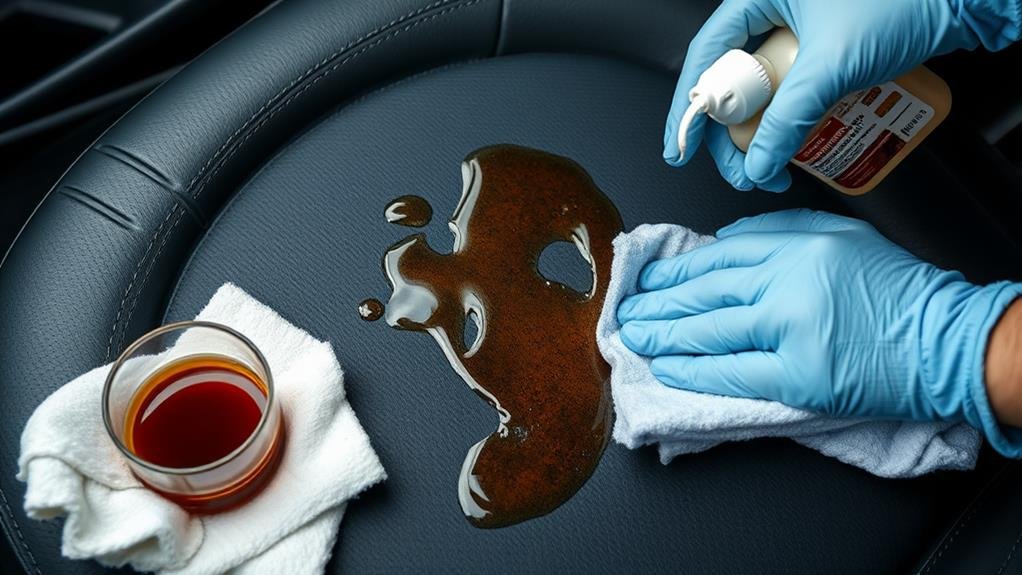
The moment you spill coffee on your car seat, you need to act quickly to prevent any lasting damage. Cleaning fresh coffee spills involves several steps that are essential for maintaining your car's interior. Swiftly responding to the spill is important to avoid permanent stains, so make sure to gather necessary cleaning supplies like clean cloths and gloves for protection immediate response is key.
First, blot the spill immediately with an absorbent material like a cloth or paper towel. This helps prevent the coffee from soaking into the fabric and setting into a stubborn stain. Don't rub the spill as it can spread and make the stain worse.
Here are the key steps to clean a fresh coffee spill:
- Blot the spill: Use absorbent materials to remove as much of the coffee as possible.
- Apply cleaner: Spray a cleaner on the stained area and gently rub with a towel or sponge to break down the residue.
- Rinse and dry: Rinse the spot with clean water, blot dry, and dry the seat using a hairdryer or by opening windows to avoid water stains.
Removing Old Coffee Stains
When dealing with old coffee stains, I find that a mixture of warm water and vinegar can be quite effective. For leather seats, it's essential to use a pH-balanced leather cleaner to safely remove the stains. These methods can help you tackle stubborn coffee stains that have had time to set into your car's upholstery.
Vinegar and Water Solution
If you're dealing with old coffee stains on your car seat, a warm water and vinegar mixture can be your best option. This method is effective because the acidic properties of vinegar help break down stubborn coffee residue, making it simpler to remove.
To start, mix equivalent parts of white vinegar and clean water. Before applying this mixture to the stained area, it's essential to test it on a hidden part of the upholstery to verify it doesn't harm the material.
Here's how you can use this mixture for coffee stain removal:
- Blend Solution: Combine equivalent parts of white vinegar and clean water in a bowl.
- Test Area: Apply a small amount of the mixture to a hidden area of the car seat to check for any adverse effects.
- Blot Stain: Use a clean cloth to blot the old coffee stains with the vinegar mixture. Do not rub, as this could harm the upholstery.
After blotting, rinse the area thoroughly to lift and eliminate the stains. Vinegar is a natural and cost-effective option that works well for addressing old coffee stains on car seats without causing harm.
Leather Cleaner Application
Removing old coffee stains from leather car seats requires a different approach than fabric or vinyl. When dealing with leather, it's important to use a product specifically designed for the task to avoid damage. A pH-balanced leather cleaner is the best option for addressing these stains effectively.
Leather cleaners are formulated to clean and condition leather surfaces without causing harm, helping to maintain the integrity and appearance of your car's leather seats over time. Before applying the cleaner to the entire stain, always test it on a small, inconspicuous area of the seat. This step guarantees that the cleaner won't discolor or damage the leather.
Once you've confirmed that the cleaner is safe to use, apply it directly to the old coffee stain and follow the instructions provided. These cleaners are designed to help remove stubborn stains while also restoring the natural beauty of your car's leather seats. By using a pH-balanced leather cleaner, you can effectively remove old coffee stains and keep your leather seats looking their best. This method not only cleans but also conditions the leather, ensuring it remains in good condition for years to come.
Specialized Cleaning Methods
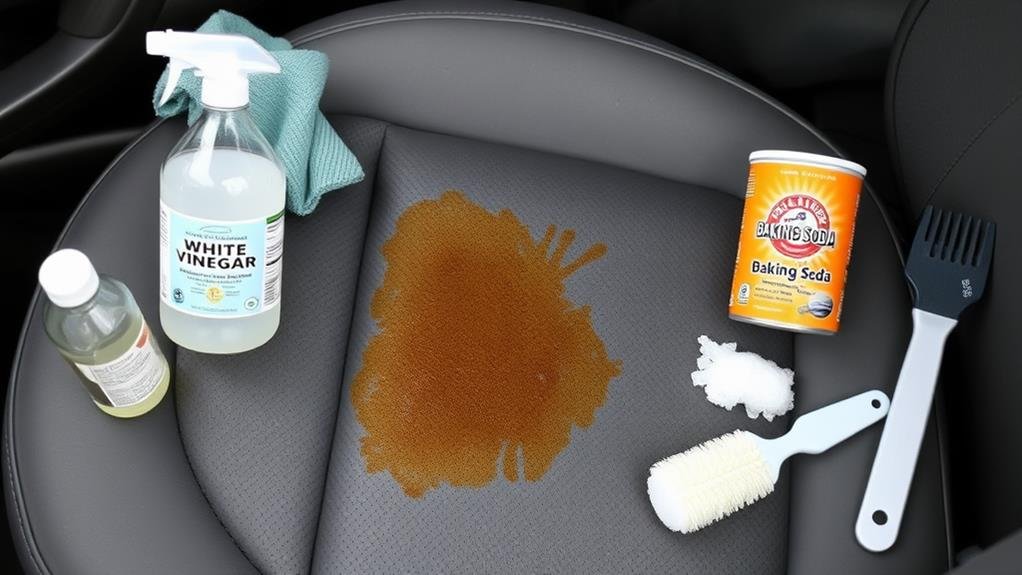
To address coffee stains on your car seats effectively, you need to employ the right cleaning methods tailored to the type of upholstery you have. For cloth upholstery, using distilled white vinegar is a great strategy. Here are some specialized cleaning methods you might find helpful:
- Vinegar Solution: Mix distilled white vinegar with water and car shampoo for a powerful cleaning mixture. This can efficiently eliminate coffee stains from fabric surfaces.
- Glass Cleaner: For tough coffee stains on fabric, consider using glass cleaner with ammonia. However, be cautious and test a small area first to make sure it doesn't harm the material.
- Baking Soda Paste: If you have vinyl stains, a baking soda paste can be applied and gently worked in with a soft brush before blotting dry.
For leather or vinyl seats, it's vital to use specific cleaners that are pH balanced to guarantee safe and effective cleaning without damaging the material. Using the wrong cleaning supplies can lead to damage, so always choose products designed for your car seat type. By selecting the right method based on your upholstery, you'll be able to eliminate coffee stains effectively and maintain your car's interior in good condition.
Preparations Before Cleaning
To start cleaning a coffee stain from your car seat, I gather all the necessary supplies like microfiber cloths, mild dish soap, and vinegar. Next, I assess the age and type of the stain to determine the most effective cleaning approach. This preparation guarantees that I have the right tools and strategy for successfully removing the stain.
Gather Cleaning Supplies
When confronting a coffee blemish on your car seat, it's vital to gather the correct cleaning supplies beforehand. This guarantees that you carry out the removal process effectively and safely. Here are some must-have items:
- Microfiber cloth: This is necessary for gently blotting and wiping away the stain.
- Gentle dish soap: A gentle dish soap can help break down the stain without harming your car's upholstery.
- White vinegar: Vinegar is a natural cleanser that can help lift and eliminate the coffee stain without leaving residue.
Having these supplies at hand will make a significant difference in your cleaning endeavors. Furthermore, consider evaluating the age and type of coffee stain before proceeding, as this may impact the approach you take. It's also prudent to consult your car manual or upholstery guidelines for specific instructions on cleaning to ensure you're using the correct products and methods. By having the proper tools and supplies, you'll be well-equipped to restore your car's interior to its immaculate condition.
Assess Stain Type
Now that you have your cleaning supplies ready, it's time to evaluate the coffee stain on your car seat. This step is pivotal because different types of stains require different cleaning methods. Start by determining the age of the stain. Fresh coffee stains are easier to remove than old ones, which may have set into the fabric.
Next, identify the type of coffee stain you're dealing with. Is it a light brown ring or a dark, stubborn blotch? Understanding the composition of the stain helps in selecting the right cleaning solution. For example, if the stain has a high concentration of oil from cream or milk, you may need a solution that can break down oils.
Identify the type of car seat material affected by the stain as well. Different materials like leather, vinyl, or fabric require specific cleaning approaches to avoid damage. Proper evaluation of the stain aids in selecting the right tools and techniques for effective removal. Knowing these details will help guide your cleaning process and guarantee you use the most efficient methods for removing the coffee stain without damaging your car seat. This careful evaluation will make the cleaning process much smoother and more successful.
Step-by-Step Cleaning Guide
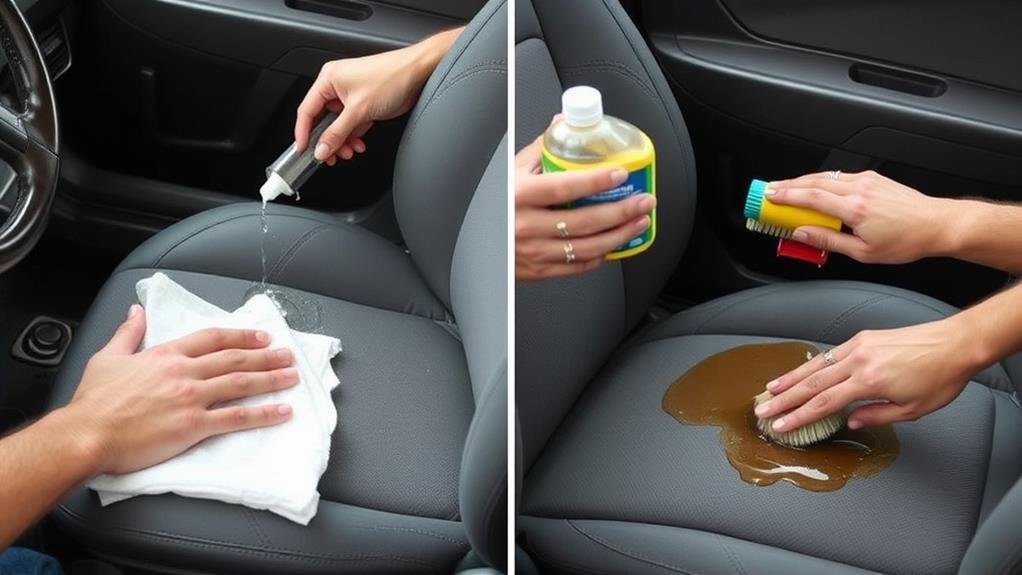
If you've ever spilled coffee on your car seat, you know how quickly it can turn into a stubborn mark. Acting fast is crucial to prevent the mark from setting in. Here's a step-by-step guide to help you clean coffee stains from your car seat.
First, blot the fresh coffee spill immediately using an absorbent cloth or paper towel. This helps prevent the liquid from seeping deeper into the fabric.
For cloth seats, mix a solution of equal parts vinegar and water. For leather seats, use cool soapy water instead. Here are some steps to follow:
- Prepare your cleaning solution: Mix the appropriate cleaning agent (vinegar and water for cloth seats or cool soapy water for leather seats).
- Dab gently: Use a soft cloth to pat at the mark with your cleaning solution until it lifts from the fabric.
- Test commercial removers carefully: Before using any commercial stain remover, test it on a small, inconspicuous area of your car seat.
Once you've removed as much of the mark as possible, make sure that the car seat is thoroughly dried to prevent water marks or damage.
Tips for Preventing Stains
To keep your car seats stain-free, taking proactive measures is essential. One of the most effective ways to prevent coffee stains is by using spill-proof travel mugs. These mugs are designed to minimize spills, which greatly reduces the risk of coffee splashing onto your car seat.
Encourage passengers to hold their coffee securely while in the car. This simple habit can go a long way in preventing accidental spills that could result in stubborn stains.
Installing seat covers is another wise move. These covers provide an additional layer of protection against coffee spills and make cleaning much easier if an accident does occur.
Keep a pack of dry cleaning cloths or baby wipes in your car for quick cleanups. This way, if a spill happens, you can address it immediately and prevent the mark from setting.
Cleaning Different Surface Types
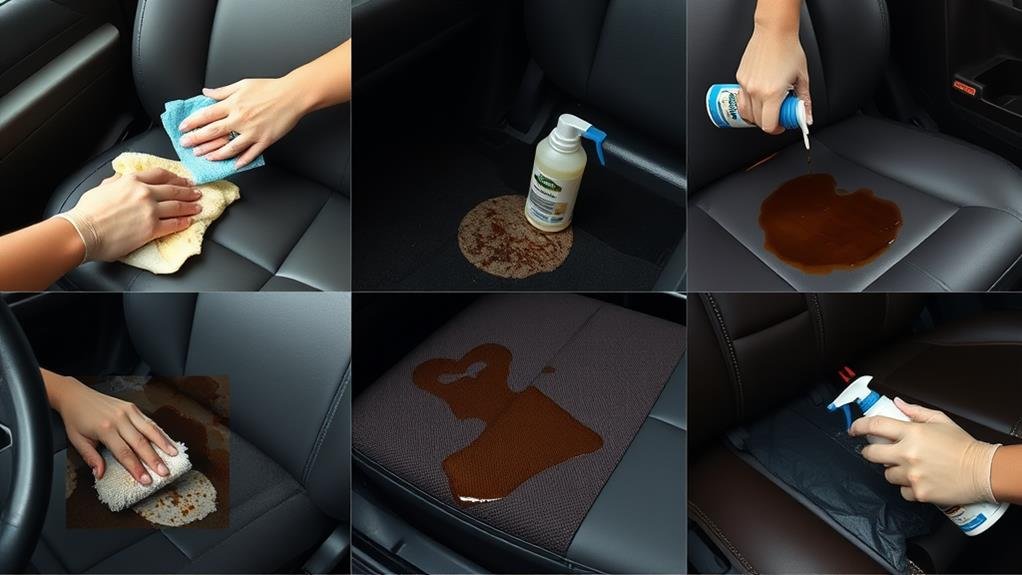
While preventive measures can greatly reduce the risk of coffee stains, accidents can still happen. When dealing with coffee stains on different car seat surfaces, it's important to use the right cleaning methods to avoid damage or discoloration.
For cloth seats, I suggest using distilled white vinegar. It's gentle and effective without leaving harsh chemical residues. On leather seats, a pH-balanced leather cleaner is your best option. This guarantees the leather remains intact and doesn't dry out.
For vinyl seats, creating a paste of baking soda and water works well for gently scrubbing away stains. Here are some key points to keep in mind:
- Test first: Always test cleaning solutions on a small, inconspicuous area before applying them to the entire stain.
- Surface-specific cleaners: Use distilled white vinegar for cloth seats and pH-balanced leather cleaner for leather seats.
- Ammonia-free glass cleaner: Avoid using glass cleaner with ammonia on fabric surfaces; instead, adhere to the recommended methods.
Seeking Professional Detailing
When dealing with particularly stubborn coffee stains on your car seats, seeking expert detailing can be the best approach. Expert detailers possess specialized equipment and expertise that allow them to tackle tough stains effectively. If you've spilled coffee in your car, they offer convenient on-site services that save you time and effort, guaranteeing your car's interior remains clean and pristine.
Regular expert detailing helps maintain your car's interior and prevents stubborn stains from setting in. Whether your car seats are made of cloth, leather, or vinyl, expert detailers follow specific cleaning protocols tailored to each material type. This ensures optimal results and thorough stain removal.
Trusting expert detailers guarantees exceptional results. They understand how to address different types of stains, ensuring that even the most stubborn ones are completely eliminated. By choosing expert detailing, you guarantee that your car's interior is meticulously cleaned, leaving it looking as good as new. This approach not only saves you time but also ensures a clean car interior with no lingering stains.
Conclusion
Removing coffee stains from car seats can be a challenging task, but with the right techniques, it's definitely manageable. While immediate action is key to preventing stubborn stains, even old ones can be tackled with the right cleaning solutions. By following these steps and tips, you can keep your car seats looking like new. Don't let coffee spills turn into lasting blemishes—act quickly and effectively to maintain your car's pristine appearance.

